Western Sydney University 401206: Life Expectancy Factors Report
VerifiedAdded on 2022/11/23
|5
|1005
|254
Report
AI Summary
This report examines the factors influencing life expectancy, with a specific focus on the Aboriginal and Torres Strait Islander populations, drawing from the 401206 Aboriginal and Torres Strait Islander Health course. The analysis utilizes Gibbs' Reflective Cycle to explore demographic, environmental, and socioeconomic factors, including race, gender, education, and income, and their impact on longevity. The report highlights the significance of cultural safety, traditional medicine, and the influence of medical advancements and genetics. It discusses the negative impacts of unhealthy social behaviors, intergenerational trauma, and the importance of education and culturally sensitive health practices to improve health outcomes and life expectancy within these communities, and it also provides references to support the claims.
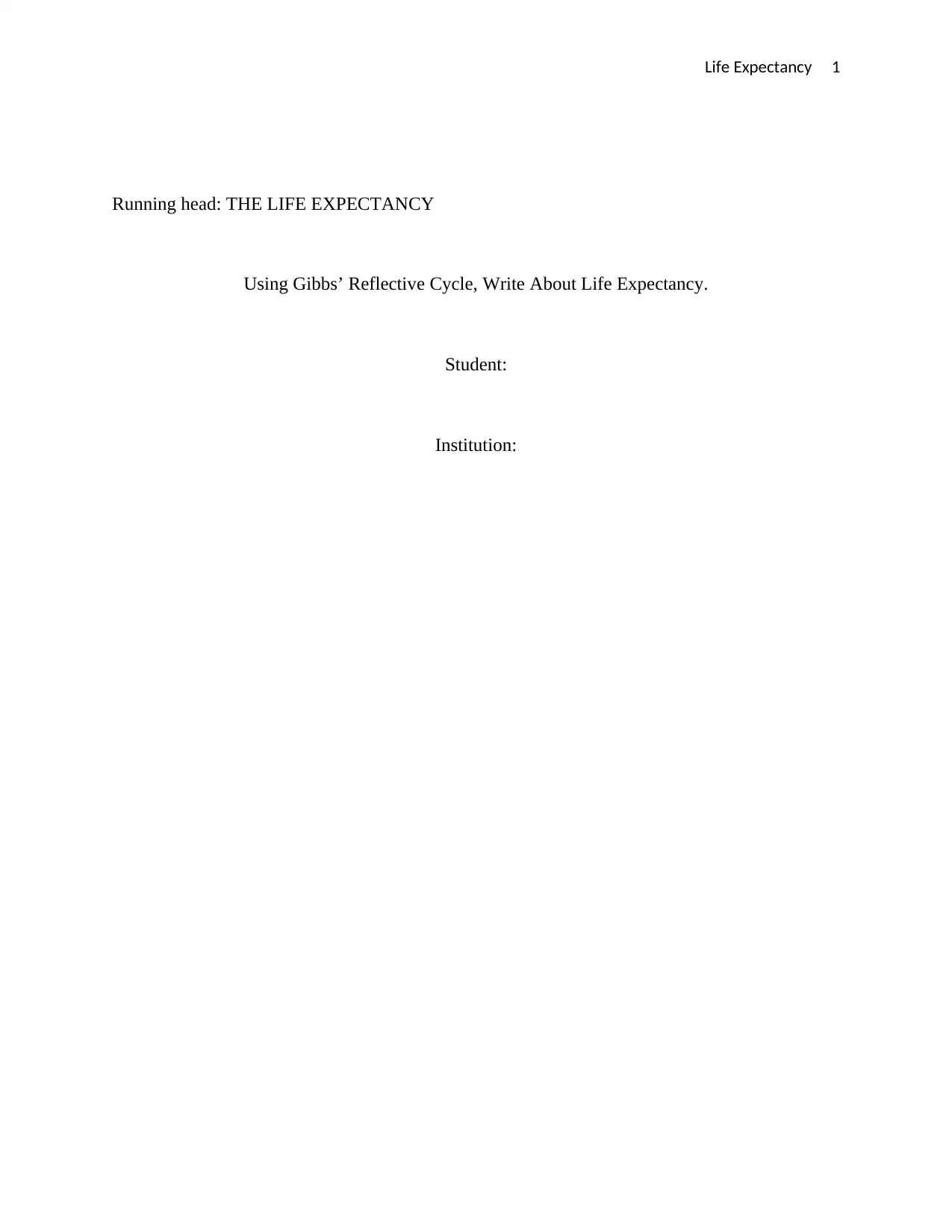
Life Expectancy 1
Running head: THE LIFE EXPECTANCY
Using Gibbs’ Reflective Cycle, Write About Life Expectancy.
Student:
Institution:
Running head: THE LIFE EXPECTANCY
Using Gibbs’ Reflective Cycle, Write About Life Expectancy.
Student:
Institution:
Paraphrase This Document
Need a fresh take? Get an instant paraphrase of this document with our AI Paraphraser
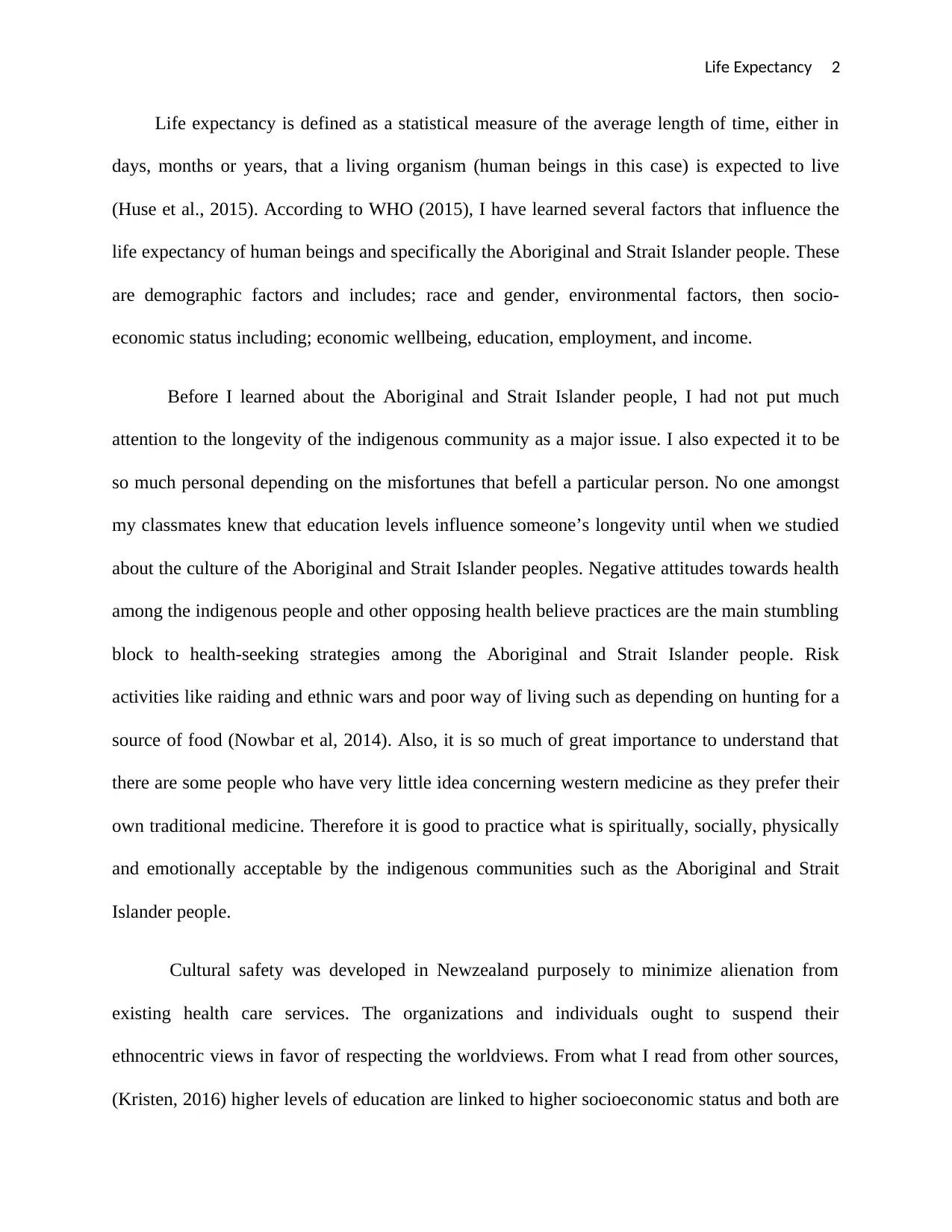
Life Expectancy 2
Life expectancy is defined as a statistical measure of the average length of time, either in
days, months or years, that a living organism (human beings in this case) is expected to live
(Huse et al., 2015). According to WHO (2015), I have learned several factors that influence the
life expectancy of human beings and specifically the Aboriginal and Strait Islander people. These
are demographic factors and includes; race and gender, environmental factors, then socio-
economic status including; economic wellbeing, education, employment, and income.
Before I learned about the Aboriginal and Strait Islander people, I had not put much
attention to the longevity of the indigenous community as a major issue. I also expected it to be
so much personal depending on the misfortunes that befell a particular person. No one amongst
my classmates knew that education levels influence someone’s longevity until when we studied
about the culture of the Aboriginal and Strait Islander peoples. Negative attitudes towards health
among the indigenous people and other opposing health believe practices are the main stumbling
block to health-seeking strategies among the Aboriginal and Strait Islander people. Risk
activities like raiding and ethnic wars and poor way of living such as depending on hunting for a
source of food (Nowbar et al, 2014). Also, it is so much of great importance to understand that
there are some people who have very little idea concerning western medicine as they prefer their
own traditional medicine. Therefore it is good to practice what is spiritually, socially, physically
and emotionally acceptable by the indigenous communities such as the Aboriginal and Strait
Islander people.
Cultural safety was developed in Newzealand purposely to minimize alienation from
existing health care services. The organizations and individuals ought to suspend their
ethnocentric views in favor of respecting the worldviews. From what I read from other sources,
(Kristen, 2016) higher levels of education are linked to higher socioeconomic status and both are
Life expectancy is defined as a statistical measure of the average length of time, either in
days, months or years, that a living organism (human beings in this case) is expected to live
(Huse et al., 2015). According to WHO (2015), I have learned several factors that influence the
life expectancy of human beings and specifically the Aboriginal and Strait Islander people. These
are demographic factors and includes; race and gender, environmental factors, then socio-
economic status including; economic wellbeing, education, employment, and income.
Before I learned about the Aboriginal and Strait Islander people, I had not put much
attention to the longevity of the indigenous community as a major issue. I also expected it to be
so much personal depending on the misfortunes that befell a particular person. No one amongst
my classmates knew that education levels influence someone’s longevity until when we studied
about the culture of the Aboriginal and Strait Islander peoples. Negative attitudes towards health
among the indigenous people and other opposing health believe practices are the main stumbling
block to health-seeking strategies among the Aboriginal and Strait Islander people. Risk
activities like raiding and ethnic wars and poor way of living such as depending on hunting for a
source of food (Nowbar et al, 2014). Also, it is so much of great importance to understand that
there are some people who have very little idea concerning western medicine as they prefer their
own traditional medicine. Therefore it is good to practice what is spiritually, socially, physically
and emotionally acceptable by the indigenous communities such as the Aboriginal and Strait
Islander people.
Cultural safety was developed in Newzealand purposely to minimize alienation from
existing health care services. The organizations and individuals ought to suspend their
ethnocentric views in favor of respecting the worldviews. From what I read from other sources,
(Kristen, 2016) higher levels of education are linked to higher socioeconomic status and both are
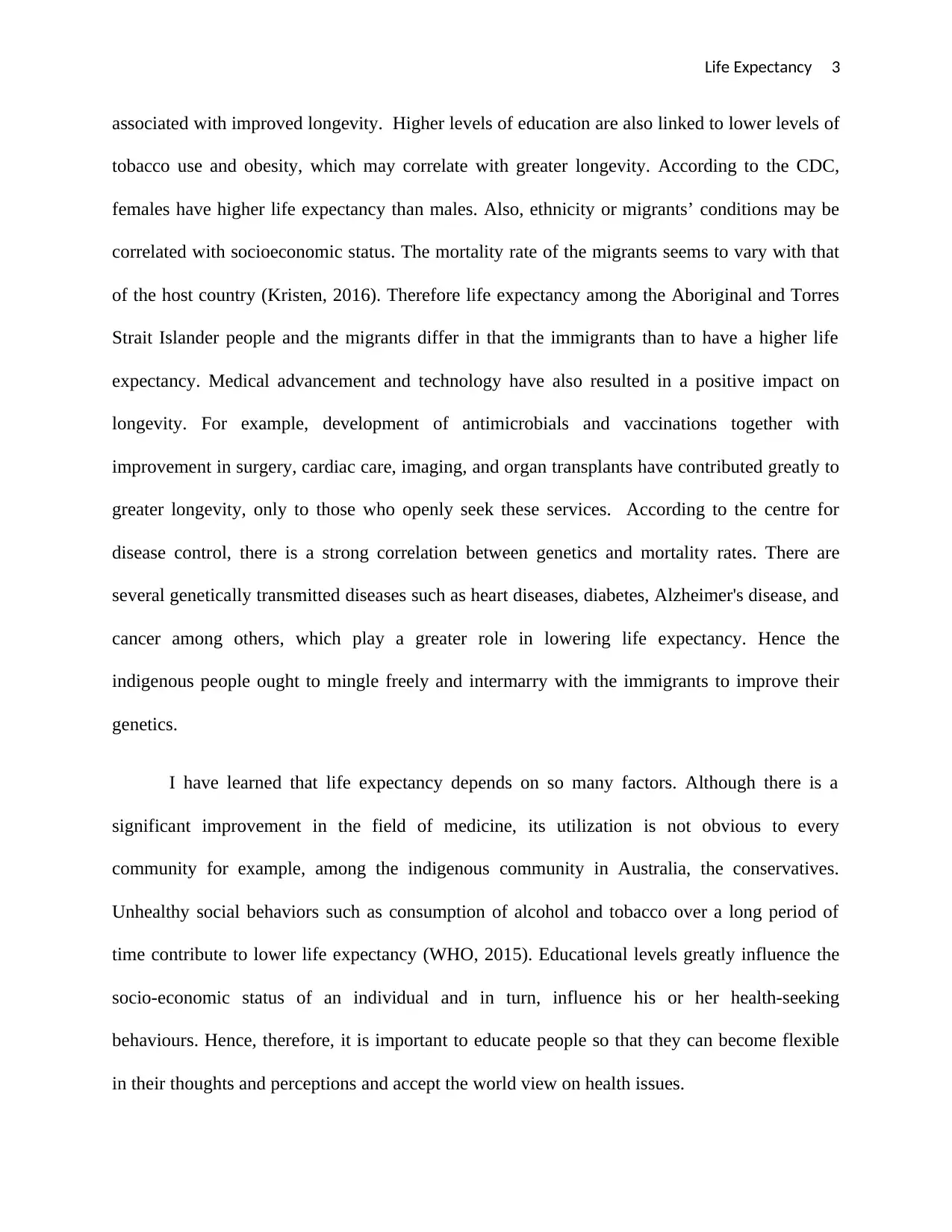
Life Expectancy 3
associated with improved longevity. Higher levels of education are also linked to lower levels of
tobacco use and obesity, which may correlate with greater longevity. According to the CDC,
females have higher life expectancy than males. Also, ethnicity or migrants’ conditions may be
correlated with socioeconomic status. The mortality rate of the migrants seems to vary with that
of the host country (Kristen, 2016). Therefore life expectancy among the Aboriginal and Torres
Strait Islander people and the migrants differ in that the immigrants than to have a higher life
expectancy. Medical advancement and technology have also resulted in a positive impact on
longevity. For example, development of antimicrobials and vaccinations together with
improvement in surgery, cardiac care, imaging, and organ transplants have contributed greatly to
greater longevity, only to those who openly seek these services. According to the centre for
disease control, there is a strong correlation between genetics and mortality rates. There are
several genetically transmitted diseases such as heart diseases, diabetes, Alzheimer's disease, and
cancer among others, which play a greater role in lowering life expectancy. Hence the
indigenous people ought to mingle freely and intermarry with the immigrants to improve their
genetics.
I have learned that life expectancy depends on so many factors. Although there is a
significant improvement in the field of medicine, its utilization is not obvious to every
community for example, among the indigenous community in Australia, the conservatives.
Unhealthy social behaviors such as consumption of alcohol and tobacco over a long period of
time contribute to lower life expectancy (WHO, 2015). Educational levels greatly influence the
socio-economic status of an individual and in turn, influence his or her health-seeking
behaviours. Hence, therefore, it is important to educate people so that they can become flexible
in their thoughts and perceptions and accept the world view on health issues.
associated with improved longevity. Higher levels of education are also linked to lower levels of
tobacco use and obesity, which may correlate with greater longevity. According to the CDC,
females have higher life expectancy than males. Also, ethnicity or migrants’ conditions may be
correlated with socioeconomic status. The mortality rate of the migrants seems to vary with that
of the host country (Kristen, 2016). Therefore life expectancy among the Aboriginal and Torres
Strait Islander people and the migrants differ in that the immigrants than to have a higher life
expectancy. Medical advancement and technology have also resulted in a positive impact on
longevity. For example, development of antimicrobials and vaccinations together with
improvement in surgery, cardiac care, imaging, and organ transplants have contributed greatly to
greater longevity, only to those who openly seek these services. According to the centre for
disease control, there is a strong correlation between genetics and mortality rates. There are
several genetically transmitted diseases such as heart diseases, diabetes, Alzheimer's disease, and
cancer among others, which play a greater role in lowering life expectancy. Hence the
indigenous people ought to mingle freely and intermarry with the immigrants to improve their
genetics.
I have learned that life expectancy depends on so many factors. Although there is a
significant improvement in the field of medicine, its utilization is not obvious to every
community for example, among the indigenous community in Australia, the conservatives.
Unhealthy social behaviors such as consumption of alcohol and tobacco over a long period of
time contribute to lower life expectancy (WHO, 2015). Educational levels greatly influence the
socio-economic status of an individual and in turn, influence his or her health-seeking
behaviours. Hence, therefore, it is important to educate people so that they can become flexible
in their thoughts and perceptions and accept the world view on health issues.
⊘ This is a preview!⊘
Do you want full access?
Subscribe today to unlock all pages.

Trusted by 1+ million students worldwide
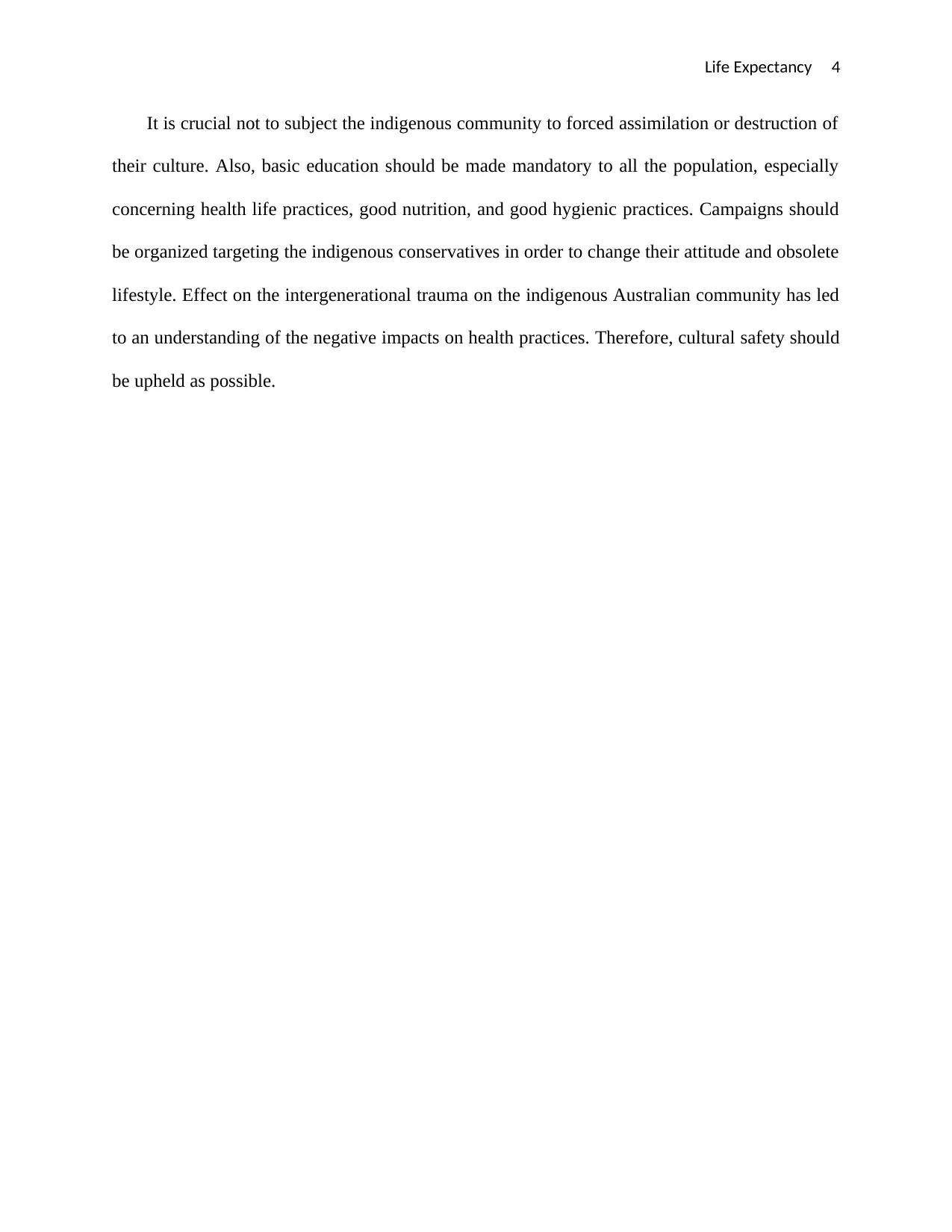
Life Expectancy 4
It is crucial not to subject the indigenous community to forced assimilation or destruction of
their culture. Also, basic education should be made mandatory to all the population, especially
concerning health life practices, good nutrition, and good hygienic practices. Campaigns should
be organized targeting the indigenous conservatives in order to change their attitude and obsolete
lifestyle. Effect on the intergenerational trauma on the indigenous Australian community has led
to an understanding of the negative impacts on health practices. Therefore, cultural safety should
be upheld as possible.
It is crucial not to subject the indigenous community to forced assimilation or destruction of
their culture. Also, basic education should be made mandatory to all the population, especially
concerning health life practices, good nutrition, and good hygienic practices. Campaigns should
be organized targeting the indigenous conservatives in order to change their attitude and obsolete
lifestyle. Effect on the intergenerational trauma on the indigenous Australian community has led
to an understanding of the negative impacts on health practices. Therefore, cultural safety should
be upheld as possible.
Paraphrase This Document
Need a fresh take? Get an instant paraphrase of this document with our AI Paraphraser
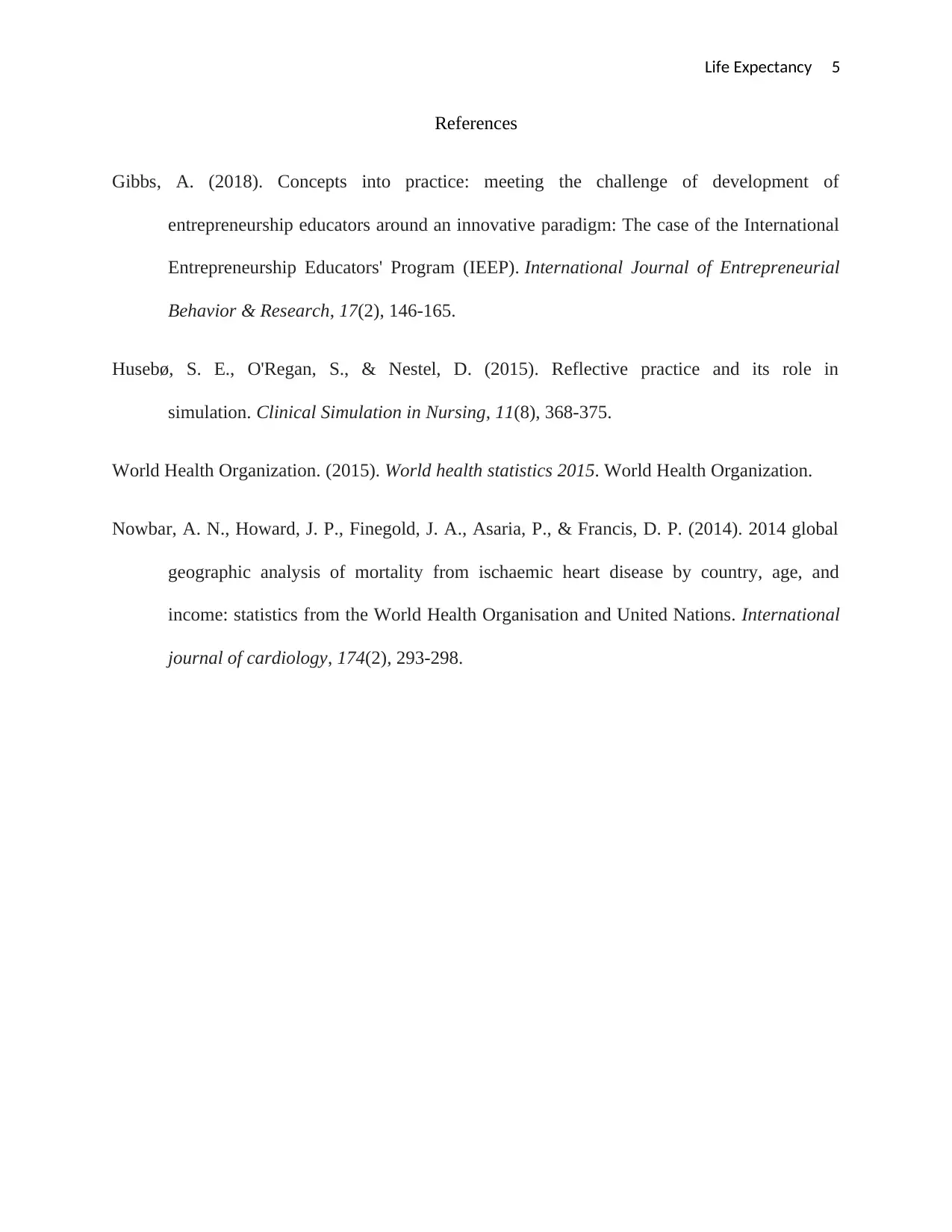
Life Expectancy 5
References
Gibbs, A. (2018). Concepts into practice: meeting the challenge of development of
entrepreneurship educators around an innovative paradigm: The case of the International
Entrepreneurship Educators' Program (IEEP). International Journal of Entrepreneurial
Behavior & Research, 17(2), 146-165.
Husebø, S. E., O'Regan, S., & Nestel, D. (2015). Reflective practice and its role in
simulation. Clinical Simulation in Nursing, 11(8), 368-375.
World Health Organization. (2015). World health statistics 2015. World Health Organization.
Nowbar, A. N., Howard, J. P., Finegold, J. A., Asaria, P., & Francis, D. P. (2014). 2014 global
geographic analysis of mortality from ischaemic heart disease by country, age, and
income: statistics from the World Health Organisation and United Nations. International
journal of cardiology, 174(2), 293-298.
References
Gibbs, A. (2018). Concepts into practice: meeting the challenge of development of
entrepreneurship educators around an innovative paradigm: The case of the International
Entrepreneurship Educators' Program (IEEP). International Journal of Entrepreneurial
Behavior & Research, 17(2), 146-165.
Husebø, S. E., O'Regan, S., & Nestel, D. (2015). Reflective practice and its role in
simulation. Clinical Simulation in Nursing, 11(8), 368-375.
World Health Organization. (2015). World health statistics 2015. World Health Organization.
Nowbar, A. N., Howard, J. P., Finegold, J. A., Asaria, P., & Francis, D. P. (2014). 2014 global
geographic analysis of mortality from ischaemic heart disease by country, age, and
income: statistics from the World Health Organisation and United Nations. International
journal of cardiology, 174(2), 293-298.
1 out of 5
Related Documents
Your All-in-One AI-Powered Toolkit for Academic Success.
+13062052269
info@desklib.com
Available 24*7 on WhatsApp / Email
![[object Object]](/_next/static/media/star-bottom.7253800d.svg)
Unlock your academic potential
Copyright © 2020–2025 A2Z Services. All Rights Reserved. Developed and managed by ZUCOL.




